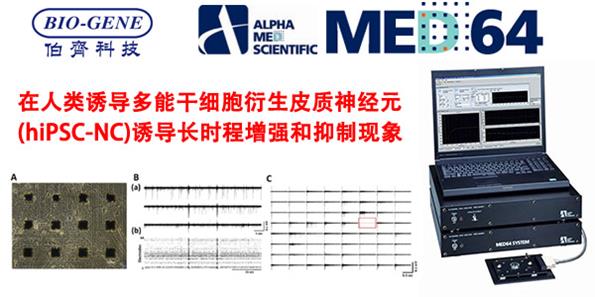
Induction of long-term potentiation and depression phenomena in human induced pluripotent stem cell-derived cortical neurons.
A. Odawara, H. Katoh, N. Matsuda, I. Suzuki
Volume 469, Issue 4, 22 January 2016, Pages 856–862
Highlights
•HFS induced LTP and LTD phenomena in hiPSC-derived cortical neurons.
•Spike patterns were generated or disappeared in induction of plasticity.
•hiPSC-derived neurons express the spike pattern with a precise timing change.
•HFS induced L-LTP-like plasticity and the change of synchronized burst firing.
•MEA system is beneficial for clarifying the function of hiPSC-derived neurons.
Abstract
Plasticity such as long-term potentiation (LTP) and long-term potentiation depression (LTD) in neuronal networks has been analyzed using in vitro and in vivo techniques in simple animals to understand learning, memory, and development in brain function. Human induced pluripotent stem cell (hiPSC)-derived neurons may be effectively used for understanding the plasticity mechanism in human neuronal networks, thereby elucidating disease mechanisms and drug discoveries. In this study, we attempted the induction of LTP and LTD phenomena in a cultured hiPSC-derived cerebral cortical neuronal network using multi-electrode array (MEA) systems. High-frequency stimulation (HFS) produced a potentiated and depressed transmission in a neuronal circuit for 1 h in the evoked responses by test stimulus. The cross-correlation of responses revealed that spike patterns with specific timing were generated during LTP induction and disappeared during LTD induction and that the hiPSC-derived cortical neuronal network has the potential to repeatedly express the spike pattern with a precise timing change within 0.5 ms. We also detected the phenomenon for late-phase LTP (L-LTP) like plasticity and the effects for synchronized burst firing (SBF) in spontaneous firings by HFS. In conclusion, we detected the LTP and LTD phenomena in a hiPSC-derived neuronal network as the change of spike pattern. The studies of plasticity using hiPSC-derived neurons and a MEA system may be beneficial for clarifying the functions of human neuronal circuits and for applying to drug screening.
神經可塑性如長時程增強(LTP)和長時程增強抑制(LTD)在神經網絡中的機制,及種種關于學習、記憶,及發育等腦功能發展已通過不同動物模型,使用離體和載體等技術來分析研究。人類誘導多能干細胞衍生的神經元(hiPSC-NC)可以有效地用于理解人類神經網絡的可塑性機制,從而闡明疾病發病機制和幫助藥物研發。在這項研究中,日本東北工業大學的研究人員試圖采用多電極陣列(MEA)系統在培養的hiPSC皮層神經元誘導LTP和LTD現象。高頻刺激(HFS)在神經元電路產生一組長達一小時的增效和抑制傳遞的誘發反應。相關的相應反應顯示,具有特別時間值的峰電位模式在LTP的誘導中產生,并于LTD誘導中消失,hiPSC-衍生的皮質神經元網絡有可能重復地表達該峰電位,時間精確度可達到0.5 ms內。研究人員也檢測到類似可塑性的后期LTP現象(L-LTP)和類似HFS的自發電位發射中的同步簇狀發射(SBF)的結果。研究人員觀察到在hiPSC衍生的神經元網絡的LTP和LTD現象伴隨峰電位模式變化。使用hiPSC衍生神經元和MEA系統可幫助研究人員研究人類神經元電路的功能和藥物篩選的可塑性研究。